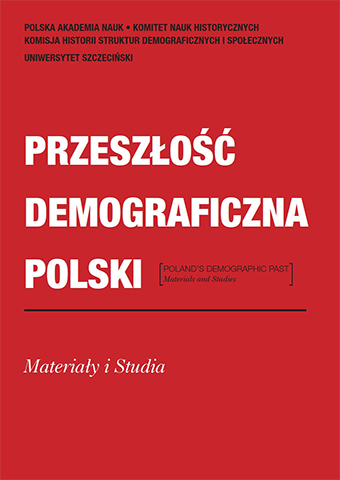







| Authors: |
Dorota
Bród
Politechnika Rzeszowska, Wydział Matematyki i Fizyki Stosowanej Piotr Rachwał Katolicki Uniwersytet Lubelski, Wydział Humanistyczny Paweł Strzelecki Szkoła Główna Handlowa w Warszawie, Kolegium Analiz Ekonomicznych |
| Keywords: | inverse projection ergodic theorem tables of life duration natural moveme |
| Data publikacji całości: | 2016 |
| Page range: | 30 (89-118) |
| 1. | Arthur, W. Brian. „The Ergodic Theorems of Demography: A Simple Proof”. IIASA Working Paper (1981): 1–10. |
| 2. | Balicki, Andrzej. Analiza przeżycia i tablice wymieralności. Warszawa: PWE, 2006. |
| 3. | Bertino, Salvatore, Eugenio Sonnino. „La proiezione inversa stocastica: tecnica e applicazione”. W: Le Italie Demografiche. Saggi di demografia storica, red. Marco Breschi, Giovanna da Molin, Lorenzo del Panta, Luigi Pace. Udine: Dipartimento de Scienze Statistiche, Università degli Studi di Udine, 1995. |
| 4. | Biraben, Jean-Noël, Noël Bonneuil. „Population et économie en pays de Caux aux XVIeet XVIIe siècles”. Population 6 (1986): 937–960. |
| 5. | Bonneuil, Noël. „The Trend Method Applied to English Data”. W: Old and New Methods in Historical Demography, red. David S. Reher, Roger S. Schofield, 57–65. Oxford: Clarendon Press, 1993. |
| 6. | Borowski, Stanisław. „Próba odtworzenia struktur społecznych i procesów demograficznych na Warmii u schyłku XVII w. na przykładzie Dobrego Miasta i okolicy”. Przeszłość Demograficzna Polski 8 (1975): 125–198. |
| 7. | Brunborg, Helge. „The Inverse Projection Method Applied to Norway, 1735–1974. Niepubl., 1976. |
| 8. | Coale, Ansley J., Paul Demeny, Barbara Vaughan. Regional Model Life Tables and Stable Populations. New York: Academic Press, 1983. |
| 9. | Cohen, Joel B. „Ergodic Theorems in Demography”. Bulletin of the American Mathematical Society 1 (1979), 2: 275–295. |
| 10. | Gautier, Etienne, Louis Henry. „Crulai. Démographie d’une paroisse normande au XVIIe et au XVIII siècles. Présentation d’un cahier de l’I.N.E.D”, Population 13 (1958), 2: 283–286. |
| 11. | Gieysztorowa, Irena. „Badania demograficzne na podstawie metryk parafialnych”. Kwartalnik Historii Kultury Materialnej 10 (1962), 2: 103–121. |
| 12. | Gieysztorowa, Irena. „Niebezpieczeństwa metodyczne polskich badań metrykalnych XVII–XVIII wieku”. Kwartalnik Historii Kultury Materialnej 19 (1971), 4: 557–604. |
| 13. | Hajnal, John. „On Products of Non-negative Matrices”. Mathematical Proceedings of the Cambridge Philosophical Society 79 (1976): 521–530. |
| 14. | Holzer, Jerzy Z. Model ludności ustabilizowanej. Warszawa: SGPiS, 1969. |
| 15. | Jóźwiak, Janina. Matematyczne modele ludności. Warszawa: SGPiS, 1985. |
| 16. | Kędelski, Mieczysław. „Piramida wieku i tablice trwania życia ludności Śląska w 1864 roku”. Przeszłość Demograficzna Polski 20 (1997): 49–73. |
| 17. | Kędelski, Mieczysław. Umieralność i trwanie życia ludności Wielkopolski w XIX wieku. Poznań: Wydawnictwo Akademii Ekonomicznej w Poznaniu, 1996. |
| 18. | Kędelski, Mieczysław, Jan Paradysz. Demografia. Poznań: Wydawnictwo Akademii Ekonomicznej w Poznaniu, 2006. |
| 19. | Kuklo, Cezary. Demografia Rzeczypospolitej przedrozbiorowej. Warszawa: Wydawnictwo DiG, 2009. |
| 20. | Kuklo, Cezary. „Polska demografia przeszłości u progu XXI wieku”. Przeszłość Demograficzna Polski 22 (2001), 7–32. |
| 21. | Lee, Ronald D. Econometric Studies of Topics in Demographic History. Niepubl., 1970. |
| 22. | Lee, Ronald D. „Estimating Series of Vital Rates and Age Structure from Baptisms and Burials: A New Technique, with Applications to Pre-industrial England”. Population Studies 28 (1974), 3: 495–512. |
| 23. | Lee, Ronald D. „Inverse Projection and Back Projection: A Critical Appraisal and Comparative Results for England”, Population Studies 39 (1985), 2: 233–248. |
| 24. | Lotka, Alfred J. „The Structure of the Growing Population”. Human Biology 3 (1931), 4: 459–493. |
| 25. | McCaa, Robert. „Benchmarks for a New Inverse Population Projection Program. England, Sweden, and a Standard Demographic Transition”. W: Old and New Methods in Historical Demography, red. David S. Reher, Roger S. Schofield, 40–56. Oxford: Clarendon Press, 1993. |
| 26. | McCaa, Robert. „Populate: A Microcomputer Projection Package for Aggregative Data Applied to Norway, 1736–1970”. Annales de Démographie Historique 2 (1998): 287– 298. |
| 27. | McCaa, Robert. „The Female Population of Chile, 1855–1964: A Microcomputer Balance Sheet Method”. Latin American Population History Newsletter 15 (1989): 9–14. |
| 28. | Okólski, Marek. Demografia. Podstawowe pojęcia, procesy i teorie w encyklopedycznym zarysie. Warszawa: Wydawnictwo Naukowe Scholar, 2004. |
| 29. | Piasecki, Edmund. Ludność parafii bejskiej (woj. kieleckie) w świetle ksiąg metrykalnych z XVIII–XX w.: studium demograficzne. Warszawa: PWN, 1990. |
| 30. | Piasecki, Edmund. „Próba sporządzenia okresowych tablic trwania życia na podstawie ksiąg ruchu naturalnego w XVIII–XX w.”. Przeszłość Demograficzna Polski 16 (1985): 139–152. |
| 31. | Szulc, Stefan. „Dawne tablice wymieralności Królestwa Polskiego i m. Warszawy”. Kwartalnik Statystyczny 5 (1928), 2: 430–444. |
| 32. | Wachter, Kenneth W. „Ergodicity and Inverse Projection”. Population Studies 40 (1986): 275–287. |
| 33. | Wrigley, Edward Anthony. „Family Limitation in Pre-industrial England”. Economic History Review 19 (1966): 82–109. |
| 34. | Wrigley Edward Anthony. „Mortality in Pre-industrial England: The Example of Colyton, Devon, over Three Centuries”, Daedalus 97 (1968), 2: 546–580. |
| 35. | Wrigley Edward Anthony, R.S. Davies, James E. Oeppen, Roger S. Schofield. English Population History from Family Reconstitution 1580–1837. Cambridge, NY: Cambridge University Press, 1997. |
| 36. | Wrigley Edward Anthony, Roger S. Schofield. The Population History of England, 1541– 1871: A Reconstruction. Cambridge: Cambridge University Press, 1981. |